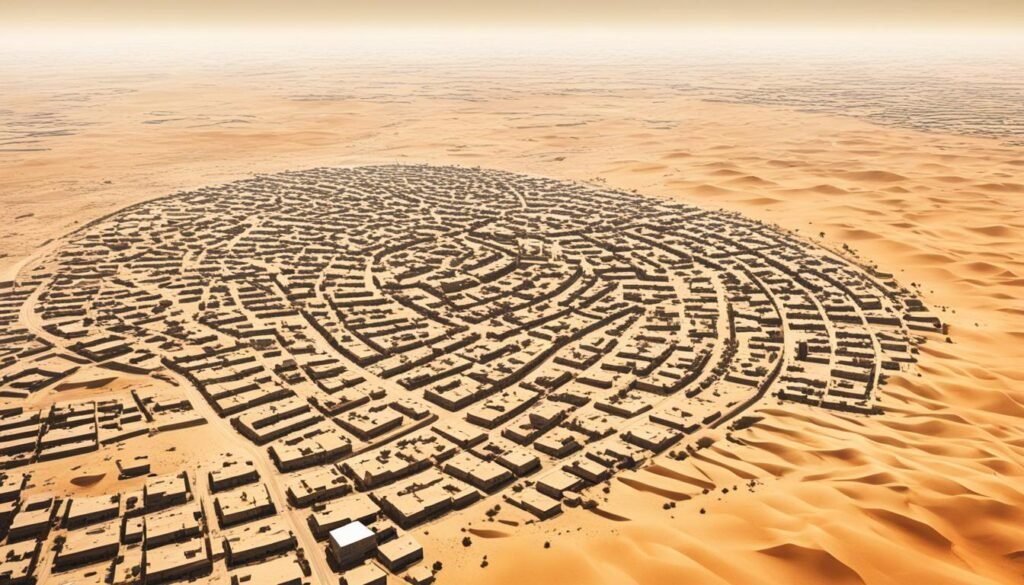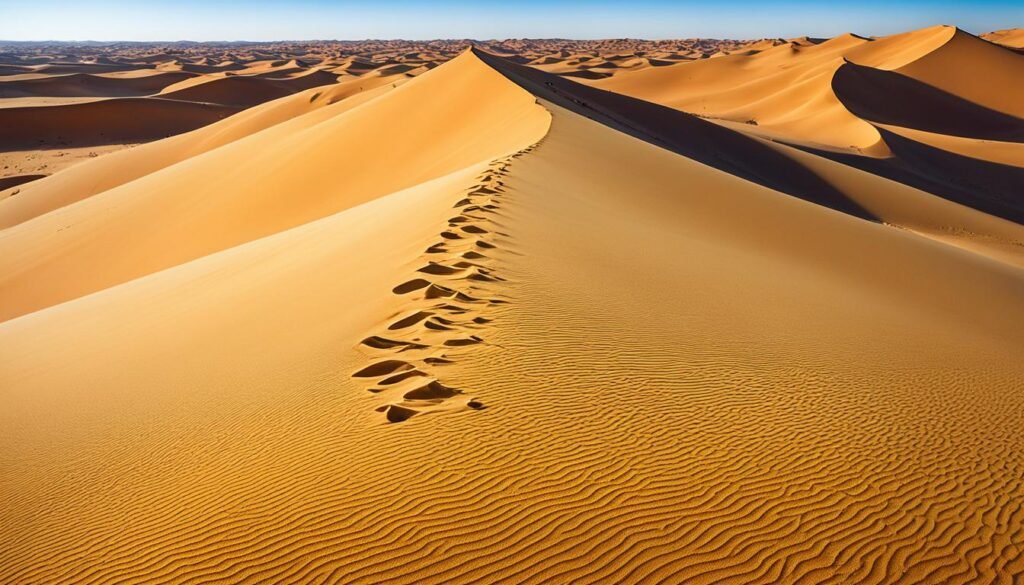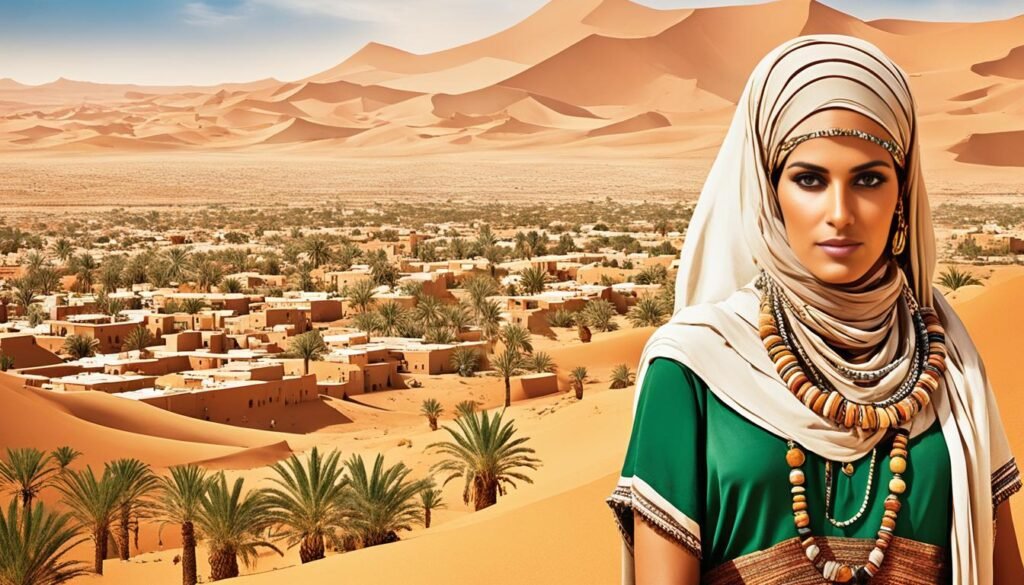Imagine a land where the sun’s relentless glare scorches the earth, where dunes of golden sand stretch as far as the eye can see, and where the rhythm of life is dictated by the whims of an unforgiving desert. This is Mauritania, a West African nation that is home to one of the world’s most arid and captivating landscapes – the Sahara Desert. Covering over three-fourths of the country, the Sahara’s influence is undeniable, shaping the very fabric of Mauritania’s ecology, culture, and way of life.
Key Takeaways
- Mauritania is a country in the Western Region of Africa, with a total area of 1,030,700 square kilometers.
- Approximately three-fourths of the country is desert or semi-desert, dominated by the Sahara Desert.
- The climate in Mauritania is characterized by extremes in temperature and meager, irregular rainfall.
- The Sahara Desert covers the northern two-thirds of the country, profoundly shaping the nation’s ecology and way of life.
- Mauritania is considered part of both the Sahel and Maghreb regions, with a diverse range of arid landscapes and ecosystems.
Geographic Overview of Mauritania
Mauritania, a captivating country in West Africa, is nestled between the vast Sahara Desert and the rugged Atlantic coastline. This arid nation is characterized by its diverse and intriguing physical features, from towering plateaus to sweeping scarps and isolated guelbs and kedias.
Location and Physical Features
Bordered by the Sahel region to the south and the Maghreb region to the north, Mauritania’s landscape is dominated by vast, arid landscapes punctuated by occasional sandstone ridges and clifflike outcroppings. The country’s topography is characterized by a series of scarps that face southwest, longitudinally bisecting the plains in the center of the nation.
Topography and Landscape
The highest point in Mauritania is the Adrar Plateau, rising to an impressive elevation of 500 meters (1,640 feet) above sea level. This vast, arid region is dotted with isolated peaks, some of which are mineral-rich guelbs and the larger kedias. The country’s diverse and captivating landscape offers a glimpse into the stark beauty of the Sahara Desert and the resilience of life in this challenging environment.
The Saharan Zone
Mauritania’s northern two-thirds is dominated by the Saharan Zone, a vast desert landscape characterized by an arid climate and extreme temperature variations. The region experiences sweltering days, often reaching over 49°C (120°F), followed by near-freezing temperatures at night. The prevailing Harmattan wind, a dry and dust-laden gale from the Sahara, frequently whips up blinding sandstorms that can reduce visibility to just a few meters.
Vegetation in the Saharan Zone is sparse, with small-leaved, spiny plants, scrub grasses, and hardy acacias clinging to life in areas where water sources are available. This harsh, desert environment supports a limited variety of wildlife, including species adapted to the extreme conditions, such as camels, gazelles, and the elusive addax antelope.

Climate and Weather Patterns
The Saharan Zone experiences an arid climate, with little rainfall throughout the year. The region is subject to intense solar radiation, leading to scorching daytime temperatures that can easily exceed 49°C (120°F). Conversely, the clear nights often result in rapid cooling, with temperatures sometimes dipping close to freezing.
Vegetation and Wildlife
Vegetation in the Saharan Zone is sparse and adapted to the harsh, dry conditions. Small-leaved, spiny plants, scrub grasses, and drought-resistant acacias are among the few species that can thrive in this desert environment. The limited water sources support a diverse array of desert wildlife, including camels, gazelles, and the elusive addax antelope, a species uniquely adapted to the Saharan landscape.
The Sahelian Zone
Extending south of the vast Saharan expanse, the Sahelian Zone in Mauritania is a diverse region characterized by its savanna grasslands and seasonal rainfall patterns. This transitional area between the desert and the lush Sudanic savannas offers a unique blend of ecosystems, supporting a wide array of flora and fauna.
The Sahelian Zone is primarily composed of steppes and savanna grasslands, providing sustenance for herds of cattle, sheep, and goats that roam the land in search of pasturage. The annual rainy season, known as the hivernage, lasts from June to October, bringing the much-needed precipitation that nourishes the region’s vegetation and sustains the livelihood of farmers and nomadic herders alike.
The seasonal rainfall patterns and the presence of the Sahelian Zone’s savanna grasslands play a crucial role in the lives of the local communities. Nomadic herding, a traditional way of life in this region, thrives on the ability to move between grazing areas and adapt to the changing weather conditions. This delicate balance between the land, the climate, and the people’s way of life is a testament to the resilience of the Sahelian Zone’s unique ecosystem.
Mauritania: Sahara Desert Ecology Nouakchott Mauritania
Ecological Zones and Sand Dunes
Mauritania’s diverse landscape is characterized by a range of ecological zones, each with its unique features. The Saharan zone, which covers the northern part of the country, is dominated by vast sand dunes that captivate the eye. These dynamic sand formations, covering 40% of Mauritania’s surface, include both fixed and shifting dunes, shaped by the relentless desert winds.
The processes of sand dune migration, such as saltation, mid-air collisions, and avalanching, pose a significant threat to the capital city of Nouakchott. As the Saharan sands encroach on the urban landscape, preventing their overwhelming advance has become a pressing priority for the Mauritanian government and international conservation efforts.
Threats and Conservation Efforts
The delicate ecological balance of Mauritania’s Saharan landscape is under constant pressure from a range of environmental threats. Overgrazing, deforestation, and unsustainable land-use practices have contributed to the degradation of fragile ecosystems. The impact of climate change, manifested through erratic rainfall patterns and rising temperatures, further exacerbates these challenges.
In response, Mauritania has embarked on a series of conservation initiatives, often in collaboration with the United Nations Environment Programme. These efforts aim to protect the country’s unique desert ecology, promote sustainable land management, and mitigate the encroachment of sand dunes on cities and agricultural areas. By embracing a holistic approach to environmental preservation, Mauritania strives to safeguard its ecological treasures for generations to come.

Vegetation Zones and Biodiversity
Mauritania’s diverse vegetation zones are shaped by the country’s varying levels of aridity. In the southern regions, the Sudanic savanna dominates, featuring the iconic baobab trees and palmyra palms. This vibrant landscape gradually transitions northward into the Sahel zone, characterized by the presence of acacia forests and euphorbia bushes, interspersed with millet grasses.
As one moves further north, the steppe vegetation disappears, replaced by the true desert landscapes of the Sahara. In these arid conditions, only scattered vegetation can be found, primarily in the wadi beds and oases. Despite the harsh environment, Mauritania’s biodiversity remains remarkable, with species such as gazelles, ostriches, warthogs, and a diverse array of migratory birds, particularly in the Banc d’Arguin National Park.
Sudanic Savanna to Desert Landscapes
The Sudanic savanna in the south gives way to the desert landscapes in the north, creating a rich tapestry of vegetation zones and biodiversity within Mauritania. This transition from lush to arid environments is a testament to the country’s adaptability and the resilience of its natural ecosystems.
People and Ethnic Groups
Mauritania is home to a diverse array of ethnic groups, each with its own unique cultural traditions and languages. The Moors, who make up over two-thirds of the population, are the dominant ethnic group, further divided into the Haratin (Black Moors) and Bidan (White Moors) subgroups. Beyond the Moors, other prominent ethnic groups include the Tukulor, Fulani, Soninke, and Wolof, all of whom have their own distinct languages and social structures.
Moors and Haratin
The Moors, both Haratin and Bidan, share a similar social hierarchy with a class system that includes nobles, dependents, and slaves. The Haratin, in particular, have a long history of slavery and marginalization, though their status has improved in recent years. The Moors are known for their Hassaniya Arabic language and nomadic pastoralist lifestyle, which has been shaped by the harsh Saharan environment.
Other Ethnic Groups and Languages
The Tukulor, Fulani, Soninke, and Wolof are other significant ethnic groups in Mauritania, each with their own distinct languages and cultural traditions. The Tukulor and Soninke, in particular, share a similar social structure to the Moors, with a hierarchy of social classes. Arabic is the official language of Mauritania, while Fula, Soninke, and Wolof are recognized as national languages, reflecting the country’s linguistic diversity.

Nouakchott: Capital City Amid the Sands
Nouakchott, the capital of Mauritania, stands as a testament to the relentless forces of nature. This coastal city, nestled along the edge of the Saharan desert, faces a constant battle against the encroaching sand dunes that threaten to overwhelm its very existence.
Satellite imagery reveals Nouakchott’s grid-like urban pattern, a stark contrast to the undulating, salmon-tinged sand dunes that surround it. These dunes, driven by the powerful Harmattan winds, are in a perpetual state of motion, advancing through processes like saltation, mid-air collisions, and avalanching. Preventing these sands from engulfing the city and its vital infrastructure has become a significant environmental challenge for the people of Nouakchott.
As the capital city and economic heart of Mauritania, Nouakchott faces the daunting task of balancing urban development with the preservation of its delicate desert ecology. Efforts to mitigate the impact of the encroaching sands, such as the construction of sand barriers and the planting of vegetation, have had varying degrees of success. The city’s resilience in the face of these environmental challenges serves as a testament to the ingenuity and determination of its residents.
Environmental Challenges and Sustainable Development
Mauritania, a country largely dominated by the Sahara Desert, faces a range of environmental challenges that threaten its delicate ecological balance. The relentless expansion of the desert, driven by climate change and unsustainable land use practices, has encroached upon agricultural lands and urban areas, including the capital city of Nouakchott.
Water scarcity is another pressing issue in Mauritania. With limited freshwater resources, the country must carefully balance the demands of its growing population and economic development with the preservation of its fragile desert ecosystems. Conservation efforts, such as the Banc d’Arguin National Park, aim to protect Mauritania’s unique biodiversity, which includes a diverse array of flora and fauna adapted to the harsh desert environment.

Sustainable development strategies in Mauritania seek to address these environmental challenges head-on. By promoting renewable energy sources, sustainable agricultural practices, and water management solutions, the country is working to mitigate the impact of desert expansion and water scarcity while fostering economic growth that is in harmony with the natural environment.
As Mauritania continues to navigate these environmental challenges, the need for ongoing conservation efforts and the implementation of sustainable development initiatives becomes increasingly crucial. Only through a holistic approach that balances the needs of the people, the economy, and the environment can Mauritania ensure a resilient and thriving future for generations to come.
Preserving Mauritania’s Unique Desert Ecology
Mauritania’s Saharan and Sahelian regions boast a remarkable desert ecology, home to rare and resilient species adapted to the harsh conditions. Preserving this fragile environment is crucial for the country’s long-term sustainability. Conservation efforts are underway to balance economic growth with environmental protection, ensuring the preservation of Mauritania’s distinctive desert landscapes and the biodiversity they support.
Sustainable development practices, such as the utilization of renewable energy and the promotion of ecotourism, are key to safeguarding the desert ecology. By harnessing the abundant solar and wind resources, Mauritania can reduce its reliance on fossil fuels and minimize the impact on the delicate desert ecosystems. Ecotourism, when implemented responsibly, can generate economic opportunities while raising awareness and funding for conservation initiatives.
Targeted conservation programs are also vital in preserving Mauritania’s unique biodiversity. These efforts focus on protecting endangered species, restoring degraded habitats, and implementing sustainable land management practices. By collaborating with local communities and leveraging scientific research, Mauritania can ensure the long-term viability of its desert ecosystems.
As Mauritania continues to develop, it must strike a careful balance between economic growth and environmental stewardship. By embracing sustainable practices and prioritizing the conservation of its desert ecology, the country can secure a future where its distinctive landscapes and their diverse inhabitants thrive for generations to come.
Conclusion
Mauritania’s Saharan and Sahelian environments present significant challenges, but also offer unique opportunities for sustainable development and environmental preservation. As the country grapples with the encroachment of the Sahara Desert, water scarcity, and other environmental threats, it must find ways to balance economic growth with the protection of its fragile desert ecology.
Through innovative conservation efforts, renewable energy initiatives, and ecotourism, Mauritania can safeguard its natural heritage while providing for the needs of its people. By recognizing the interconnectedness of its desert landscapes, biodiversity, and human communities, Mauritania can chart a path towards a more sustainable future for the Sahara Desert, Nouakchott, and the nation as a whole.
Mauritania’s commitment to sustainable development and environmental conservation will be crucial in preserving the remarkable biodiversity of its Sahara Desert ecology. Through collaborative efforts and a holistic approach, the country can ensure that its unique natural wonders are protected for generations to come.
Source Links
- Mauritania – Desert, Wildlife, Flora – https://www.britannica.com/place/Mauritania/Plant-and-animal-life
- Nouakchott, Mauritania – https://earthobservatory.nasa.gov/images/6234/nouakchott-mauritania
- Geography of Mauritania – https://en.wikipedia.org/wiki/Geography_of_Mauritania


